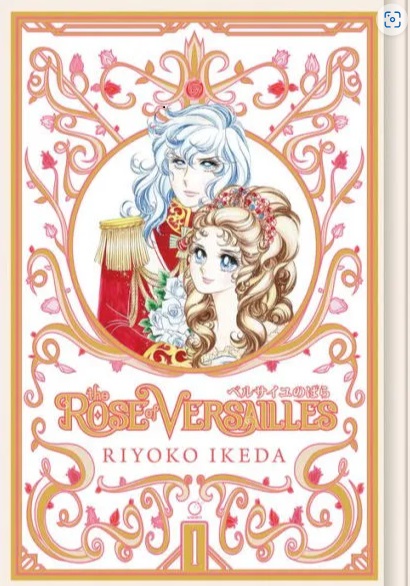Manga Review: The Rose of Versailles #1 by Ryoko Ikeda
In 1755, three children of destiny were born. Hans Axel von Fersen of Sweden, Oscar Francois de Jarjayes of France, and Maria Antonia Josephe Jeanne de Lorraine D’Autriche of Austria. The latter would become famous under her transliterated name of Marie Antoinette, the Queen of France and the Rose of Versailles. Hans had a fairly normal childhood and upbringing for a Swedish noble, so we’ll check back in on him later.

Oscar was born the youngest daughter of six of the de Jarjayes family, who had a proud tradition of serving in the Royal Guards, brave soldiers every one. Her father, desperate to keep that tradition alive, decided to raise his child as though she were a boy. Remarkably enough, she took to this like a duck to water.
Maria Antonia was the ninth child of Empress Maria Theresa of Austria. She was an extraordinary beauty with a sweet nature, but something of an airhead who constantly shirked her studies and was rather gullible. Nevertheless she was considered a potentially valuable pawn, and as part of an alliance between Austria and France, she was engaged to the grandson of KIng Louis XV, the Dauphin who would someday become King Louis XVI.
In 1770, Maria Antonia left Austria forever, moving to France to marry young Louis as Dauphine Marie Antoinette. Part of her escort was the young Royal Guard Oscar. Intrigued by the idea of a beautiful woman who dressed and rode like a man, Marie soon made Oscar one of her favorites. (It helped that Oscar was one of the sanest people at court due to her liminal status.)
The common people of France dared hope that this sweet and pure maiden would be a good influence on their next king, bringing prosperity and lower taxes. They were to be bitterly disappointed, but who could have fully foreseen the tragedy to come?
This shoujo manga was first published in Weekly Margaret in 1972, and quickly became a massive hit. Ryoko Ikeda’s flowery, sparkly art style worked very well with the period costumes, and the various romantic subplots built interest in the young female audience, even as they were reminded that it was all going to end in tears. Oscar was inspired by the earlier Sapphire of Princess Knight, though the person she was loosely based on was (so far as we know) biologically male. As the manga continued, she became more and more the star.
There have been multiple adaptations, including the classic anime series which I reviewed on this blog a while back, and it’s perennially in the repertoire of the Takarazuka all-female theater troupe. Plus many, many manga and anime series feature shoutouts or stylistic elements similar to Bara no Berusaiyu.
Among the dramatic subplots is Marie Antoinette clashing with Madame du Barry, the old king’s mistress, who fears losing her influence at court since she has no actual position of her own. We are also introduced to Jeanne and Rosalie, two peasant girls whose mother used to be a servant in the house of the last of the Valois line. (The people who used to be kings before the Bourbon Dynasty took the throne.) Maman claims that they’re the byblows of her old master.
Jeanne takes this thin claim to noble blood very seriously, and schemes to capitalize on it to rise in rank, regardless of the cost to other people. She’s a ruthless little schemer. Rosalie, by contrast, is a sweet-natured girl who is compassionate to a fault, and supports their ailing mother after Jeanne ditches them. But it turns out that Rosalie may have a secret of her own.
Fersen comes into the story as a long-term visitor to Versailles, a handsome and dashing fellow who is everything the rather dull and plain Louis XVI is not. Marie Antoinette takes a strong liking to him, perhaps too strong for their own good, as Fersen finds himself reciprocating her admiration.
While the forces that will lead to the French Revolution are glimpsed in small bits, this early volume only covers up to 1777, relatively early in King Louis XVI’s reign. Marie Antoinette is treated as not meaning any harm, but given to frivolity. boredom and trusting the wrong people when it comes to the people’s tax dollars.
This omnibus edition comes in a handsome hardback, with an embossed cover and multiple color pages.
Content note: Murder and attempted murder. Mention of extramarital infidelity, slut-shaming, misogyny. An eleven-year-old girl is told she’ll be marrying a much older man “who likes young girls.” (This is treated by the courtiers as legal but disgusting, and purely a political move.) Classism runs rampant, and there’s social bullying. Junior high readers on up should be able to handle it, but may need a bit of adult guidance.
This is one of the all-time greats, well worth reading. The art style may seem old-fashioned, but it has its own charm (and every so often switches to a more gag style for moments of humor.) Recommended to fans of romantic tragedy, Marie Antoinette buffs, and those who want to know more about manga history.

